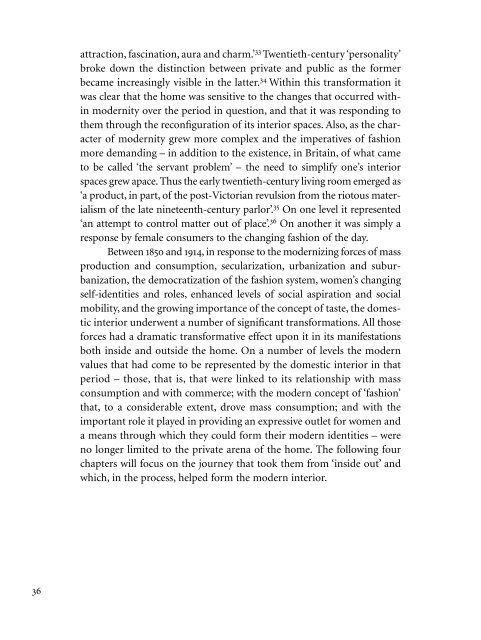You also want an ePaper? Increase the reach of your titles
YUMPU automatically turns print PDFs into web optimized ePapers that Google loves.
36<br />
attraction, fascination, aura and charm.’ 33 Twentieth-century ‘personality’<br />
broke down the distinction between private and public as the former<br />
became increasingly visible in the latter. 34 Within this transformation it<br />
was clear that the home was sensitive to the changes that occurred within<br />
modernity over the period in question, and that it was responding to<br />
them through the reconfiguration of its interior spaces. Also, as the character<br />
of modernity grew more complex and the imperatives of fashion<br />
more demanding – in addition to the existence, in Britain, of what came<br />
to be called ‘the servant problem’ – the need to simplify one’s interior<br />
spaces grew apace. Thus the early twentieth-century living room emerged as<br />
‘a product, in part, of the post-Victorian revulsion from the riotous mater -<br />
ialism of the late nineteenth-century parlor’. 35 On one level it represented<br />
‘an attempt to control matter out of place’. 36 On another it was simply a<br />
response by female consumers to the changing fashion of the day.<br />
Between 1850 and 1914, in response to the modernizing forces of mass<br />
production and consumption, secularization, urbanization and suburbanization,<br />
the democratization of the fashion system, women’s changing<br />
self-identities and roles, enhanced levels of social aspiration and social<br />
mobility, and the growing importance of the concept of taste, the domestic<br />
interior underwent a number of significant transformations. All those<br />
forces had a dramatic transformative effect upon it in its manifestations<br />
both inside and outside the home. On a number of levels the modern<br />
values that had come to be represented by the domestic interior in that<br />
period – those, that is, that were linked to its relationship with mass<br />
consumption and with commerce; with the modern concept of ‘fashion’<br />
that, to a considerable extent, drove mass consumption; and with the<br />
important role it played in providing an expressive outlet for women and<br />
a means through which they could form their modern identities – were<br />
no longer limited to the private arena of the home. <strong>The</strong> following four<br />
chapters will focus on the journey that took them from ‘inside out’ and<br />
which, in the process, helped form the modern interior.



